Lightning Safety and Preparedness
Summer is the peak season for one of the nation’s deadliest weather phenomena— lightning. But don’t be fooled, lightning strikes year round. An average of 62 people are killed each year by lightning, hundreds more are injured and damage from lightning strikes in the form of electric damage and fires range into the tens of millions. Awareness, education and preparations can save lives, health and property. While some areas are more prone to strikes than others, lightning can be a danger nearly anywhere.
How Lightning Strikes Occur
Static electricity builds up on the clouds as they move through the sky. Charges of several million volts are not uncommon. Whenever a charge builds up, it will seek to neutralize itself. This is because all systems attempt to come to rest in the state that requires the lowest energy. In the case of the earth and the surrounding environment—of which the sky is a part—the lowest state for electricity is usually found in the earth itself. This is normally called earth ground. Because the air itself is an insulator —meaning that current does not readily flow through open air—the charge in the clouds must reach large values before it will arc across the air.
Another example of this type of phenomenon is the spark jumping the gap of a spark plug in your car. When electricity arcs, it is visible to the naked eye and can be heard. When it happens in the sky, it’s called lightning and thunder. Lightning contains a lot of power. Lightning typically delivers 100,000,000 volts and can create heat along its path of up to 60,000 degrees F. Bolts of lightning most often branch out many times like a large Christmas tree. They usually occur singly, but occurrences of two and three simultaneous bolts have been captured on film.
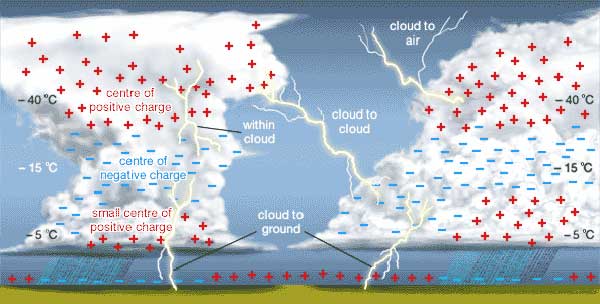 |
Lightning usually takes one of two forms: cloud-to-cloud and ground strikes. Most lightning is from one cloud to another. This is to be expected, because there is a smaller distance from cloud to cloud than there is from a typical cloud to the ground. The resulting lightning can come in sheets and light the sky. Ground strikes are less common, but much more frightening. They frighten us because cloud-to-cloud strikes don’t hit us (or things near us), whereas ground strikes may.
Air as an Insulator
Air belongs to a class of materials called insulators. All materials fall under one or the other of the following classes: conductor, semiconductor, and insulator. Conductors allow electrical current to flow easily. Semiconductors resist electrical current flow unless a foreign substance, called a dopant, is added. Dopants are usually phosphorus or boron. Insulators resist electrical current flow vigorously.
Current will flow through an insulator if there is a sufficient voltage difference at either end of the insulator. We can measure how well an insulator resists the flow of current; the resistance is measured in ohms per unit area. If an insulator has a rating of 10 ohms per unit area and is 15 units long, the total resistance is 150 ohms. It’s easy to see that if the distance between two clouds is 1000 meters, while the distance between a cloud and the ground is 3000 meters, then the resistance between the clouds is smaller than the resistance between the cloud and the ground. Because air is an insulator, in order for lightning to arc to the ground, there has to be a whole lot of power behind it to break down the insulator and create an intermediate state of air called plasma.
Lightning follows a path that it continuously creates in front of itself made out of plasma. A small bolt reaches the ground, and then a much larger return bolt flows from the ground (or the object struck), back along the exact same path. Therefore, anything that gets hit by lightning gets hit twice… double the fun and double the damage.
Light, Heat, Ionization, Explosion
In a lightning strike, electrical power can manifest in one of four ways: light, heat, ionization, and explosion. Lightning is very bright, of course. Some of the power in the lightning bolt is dissipated, or used up, in the characteristic light associated with it. A similar phenomenon is used to make light in light bulbs. As current flow through the bulb’s filament, light is produced, along with heat. Remember that when a tree is struck by lightning it usually catches fire. That’s the heat in the lightning bolt. Think of the lightning bolt as the filament. Heat isn’t as big an effect as it might be (given all that power), because lightning is a transient, or temporary, occurrence.
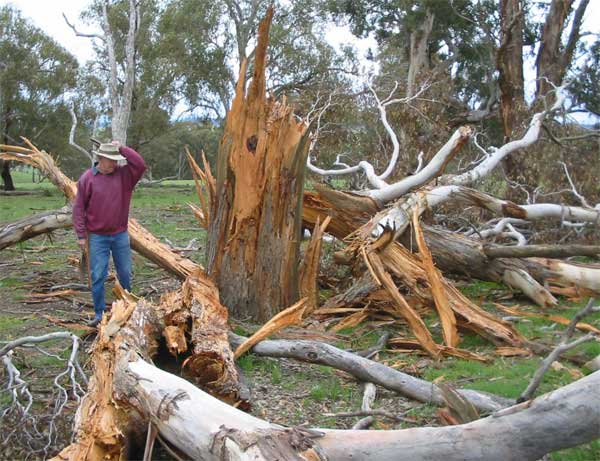
Sometimes a smell of ozone is in the air after a lightning strike. Ozone is a form of oxygen in a different configuration than the one we’re used to. It has the chemical formula O3 (that is, the ozone molecule is made up of three oxygen atoms), while normal air is O2. So much power is dumped into the air that it actually rips air molecules apart (an example of ionization) and rearranges them. The last sign is explosion. When lightning strikes something, so much power enters the thing that is struck that the power can’t all be absorbed. The object of the strike tries to convert the power into heat and can’t handle all the heat. The result is an explosion.
When lightning strikes an object, a great deal of current suddenly flows through the object being hit. Current has several by-products, including heat, fire, explosion, vaporization, and electrocution. Heat results because everything has electrical resistance. Even metal (a conductor) has a minute amount of resistance, although it is much smaller than in non-conductors. Power is dissipated across a resistor, and the power that is used up changes form and becomes heat.
Since all materials have some kind of resistance, when lightning strikes an object, an enormous amount of heat can be created. Whenever the heat exceeds the flash point of a flammable material, it will catch fire and burn. Paper, for example, burns at 451 degrees F, hence the name of the classic novel Fahrenheit 451. This explains why trees and wooden buildings catch fire when hit by lightning. If sufficient energy is transferred (as heat) from the lightning bolt to the object that is struck, the moisture in the object becomes gas. That gas expands so rapidly that pressure builds up, and the object explodes. A tree that gets hit and explodes suddenly becomes a wooden grenade, complete with shrapnel, and may drop large limbs on someone standing beneath it.
With sufficient current, the muscles in the body contract. When the muscles contract, the body can involuntarily strike things. This can result in secondary injuries if something hard or sharp is hit, and you could conceivably hit yourself. Muscle contraction begins at about 0.02 amps, less than the current required to light up one light-emitting diode. As long as the current is applied, the muscles remain contracted. The same mechanism is used by the brain to make the body move. Only 0.07 amps are required to stop the heart, a condition known as electrocution. As little as 175 volts can stop the heart if the victim is wet with sweat or other ionized moisture. Electrocution can happen quickly and be complicated by burning and destruction of tissue along the path of the current.
If You Feel It Coming, Dive!
Can you tell when you are about to be struck by lightning? There is often a warning: a feeling similar to what happens when you touch a static electricity generator, or when you take the clothes out of the dryer and separate a staticky sock from a towel. This is to be expected, since lightning starts as static electricity that breaks down the air to neutralize the charge. The result is that people about to be hit can feel the hair on their bodies stand on end and sometimes report a tingling sensation. If you are in a storm and feel this, act immediately. This is all the warning you are going to get. Get as low as you can to the ground. If you are not the highest point around, you are less likely to be hit. If you can find a nearby ditch or draw, get into it. Rolling to the ditch is much smarter than running there. Rolling in something wet will also help to get rid of the charge accumulation on your body. Avoid holding on to anything metal. If you have a tool in your hand, drop it. If you are touching a metal object, get away from it. If you are on a roof, get off. Don’t do anything that will make you a more attractive target for the lightning.
It’s easy to detect an oncoming storm with your TV. Turn on your set to Channel 2 and turn the sound all the way down. Next, adjust the set so that the contrast turns the screen just barely black. Lightning will cause the screen to flash white. This works because lightning emits energy on a lot of frequencies at the same time (broad band emissions). Since even the small portion of the lightning energy emitted as radio frequencies is huge, your TV antenna picks this up and tries to interpret it as a picture. The worse the lightning, the more frequent and brighter the screen flashes will be. This will give you some idea when a bad storm is heading your way without having to expose yourself to the weather.
Lightning Rods
Some damage to buildings and land can be averted by employing lightning rods. The role of lightning rods is to attract lightning and direct its energy to a safe target: the ground. The idea is that you can control where the lightning hits and steer it away from people, property, trees, and livestock. The key to using the lightning rod effectively is to put it up high and ground it well. Plan on using three or four on a building to make it really safe.
Lightning rods are lengths of heavy metal, sometimes with radiating metal fingers, that are mounted at the highest point of a building or other structure. They are connected to ground with a heavy wire cable through a stake or ground rod. There is a range of commercially available rods with mounting brackets that work well. See your local hardware or building supply dealer.
After mounting your rod on the highest point of the structure, you must connect it to the ground. Actual earth is the ground that you need. Remember that there will be a whole lot of power running through the cable. If you use a small wire, it will melt, and then the only path to ground from the lightning rod will be the structure you are trying to protect—so don’t skimp. You need to use a large cable to connect the lightning rod to the ground. Cable is used, instead of wire, because of the large current that will have to pass to ground if the lightning rod is struck. Since the resistance of wire or cable is directly related to its diameter (higher resistance for lower diameter), and since the purpose of the unit is to attract lightning by making the path to ground as easy as possible, it stands to reason that the larger the cable, the better. Large lightning rods have cables as large as 3/4″ to 1″ in diameter. Smaller rods typically use 1/8″ to 1/4″ diameter cables. Rods that pound right into the roof of a house can usually get away with 1/8″ diameter cable. Rods that mount to the roof with a bracket should have 1/4″ diameter cable, minimum.
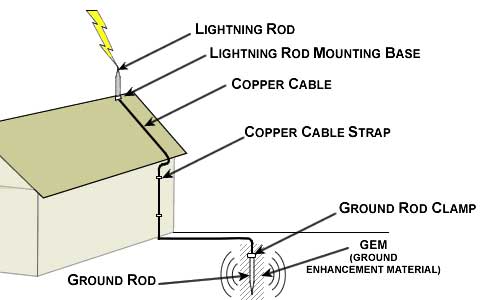
Almost all cable used for lightning rods is stranded cable made of steel. Copper cable is sometimes used when and where available. Although copper tends to have less resistance than steel, it also tends to be more expensive. The difference in resistance is minimal in practice, so use whatever is cheaper. Smaller-diameter wire may be insulated, but don’t count on larger cable having any insulation. When mounting the rods, connect the cable and loop it around the base of the rod and then through the mount, if there is one.
Usually the cable is terminated to either a stake in the ground or a buried ground rod. The best metal to use for this purpose is copper. Stakes should be at least four feet long and 1/2 inch in diameter. Rods should be at least six feet long and 1/2 inch in diameter. Count on changing these every four to eight years, depending on the amount of moisture in the ground.
Do lightning rods work? You bet! They are in use around the world for over two hundred years with proven effectiveness. Wherever you have frequent lightning you will find—and should be using—lightning rods.
Power Surges
Lightning can hit a power grid or generator. This happens all the time throughout the world. Lightning is attracted by the alternating voltage when it drops to its negative value. Typical power grids are 110/120 volt three-wire systems (although there are also 220 and 440 volt systems). Part of the regular variation in voltage in the system is one of the wires going to the negative peak. In a 110 volt system, voltages will vary between 110 and minus 110 volts. Normally the earth is at ground (0 volts), so called because that is the normal voltage of a plot of dirt. As the power lines go below 0 volts, lightning will be more strongly attracted to them. When lightning hits the grid or generator, the energy has to go somewhere, and that somewhere is right into your house! If you haven’t protected your home and electronics, there is a good chance that components in one or more of your electrical devices will be destroyed. The more common lightning strikes are in your area, the greater the chance that this will happen to you.
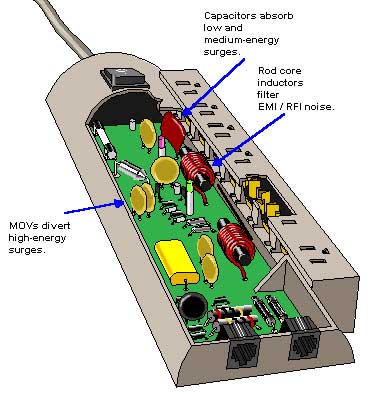 These power surges, or transients (so called because they are short and powerful), can be handled by using a couple of strategies. The first is to use a surge protector on all of the electrical appliances in the house. Many commercial models are available at Radio Shack, building supply stores, and other electrical or computer supply houses. These detect surges and react in a very short time, usually from micro- (1/1,000,000) to nano- (1/1,000,000,000) seconds. You must manually reset the protector each time it is tripped. Costs range from $10 to $100 for five outlets on the strip. More electrically handy people put dual transorbs and metal oxide varistors (MOVs) between the power lines and the point of entry to the house. Note: Don’t attempt this yourself, unless you really know what you’re doing; otherwise, call in a professional.
These power surges, or transients (so called because they are short and powerful), can be handled by using a couple of strategies. The first is to use a surge protector on all of the electrical appliances in the house. Many commercial models are available at Radio Shack, building supply stores, and other electrical or computer supply houses. These detect surges and react in a very short time, usually from micro- (1/1,000,000) to nano- (1/1,000,000,000) seconds. You must manually reset the protector each time it is tripped. Costs range from $10 to $100 for five outlets on the strip. More electrically handy people put dual transorbs and metal oxide varistors (MOVs) between the power lines and the point of entry to the house. Note: Don’t attempt this yourself, unless you really know what you’re doing; otherwise, call in a professional.
Transorbs are components that carry current after a certain voltage is exceeded. This is called the trip voltage. The transorb keeps the voltage between the two lines at a set voltage and won’t allow it to go any higher. This prevents your appliances from being damaged by the application of too great a voltage at their inputs. Transorbs can absorb a lot of current but turn on more slowly than MOVs. They are rated in the number of kilovolts that they can handle. Never use a smaller-rated unit than 1.5 kV. The 5kV units are good all around choices to maximize protection and minimize cost. Most power grids, or power distribution systems, have voltage variations of 10% – 20%. This means that a 110V grid can vary between 88V and 132V, so rate the trip voltage for the transorbs at least 30% above the nominal, or rated normal voltage, for your grid. Make sure that you use the type of transorbs for AC (alternating current) lines.
MOVs react very quickly to surges but have the tendency to allow the voltage between power lines to get further apart. In other words, they don’t clamp well if the inputs vary slowly. Their operational characteristics specify the normal voltage applied to them. As with transorbs, specify the operational voltage at least 30% over the nominal grid voltage.
MOVs and transorbs are placed between individual power lines. And it’s worth saying again: Don’t attempt this if you are unsure or unfamiliar with electricity. Remember always put SAFETY FIRST.
Counting the Distance
There’s an old saying that you can tell how far away lightning is by counting the time between seeing the flash of lightning and hearing the thunder. This is absolutely true. The propagation of sound through the air is about 300 meters/second (about 1000 feet/second). Light travels much faster, about 30,000,000,000 meters/ second (just over 186,000 miles/second) and is in effect instantaneous. Counting each second (“one one thousand one, one one thousand two”) will give you a rough idea of the time elapsed. Dividing the number of seconds by five will give the distance to the lightning in miles.
Protect Yourself
Protecting yourself during a lightning storm is easy. All you need to do is remember a few simple rules:
- If possible, don’t go out in a thunderstorm. This means that you need to be aware enough of the weather to know when one is coming.
- If you are out in a storm, make sure that you are not the highest point. Stay off the top of hills. Don’t make yourself look taller to the lightning by holding things up or holding on to trees or structures. Stay off roofs.
- In a thunderstorm, don’t take refuge under a tree. The tree may be hit and explode and turn into shrapnel, or fall on you.
- Stay away from metal. Metal generally attracts lightning. This also means that you should not shower or bathe during storms. Your pipes are made of metal, and current flows through wet things, including people.
- Don’t sit on the toilet if you can help it. You’re sitting right in the way of a direct ground.
- Pay attention to your body. It will tell you if you are about to be hit. When you feel the warning signs (a feeling of static electricity, hair standing on end, a tingling sensation), take action immediately: get low (roll into a ditch if possible).
- Don’t talk on landline telephone. The phone lines are not immune to lightning strikes.
- If you are in a high-lightning area, such as Florida, use lightning rods on your buildings and install surge protection for your house and electronics.
You might survive a lightning strike (many people have), but it’s a heck of a lot nicer if you don’t have to try.
Additional Research:
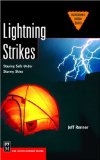   |

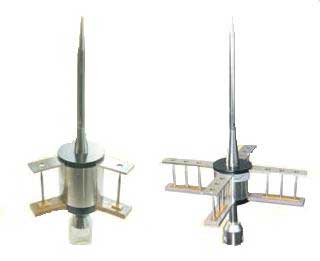




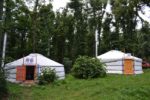

Leave a Reply